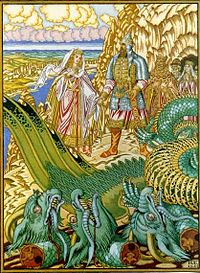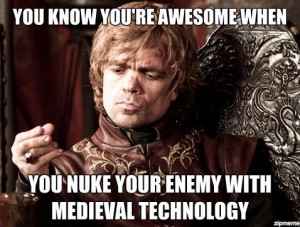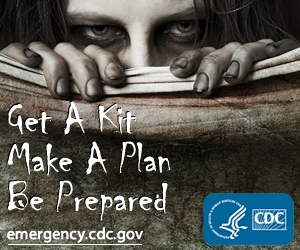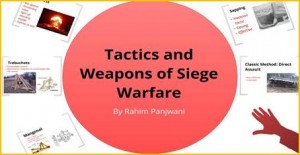
Image from J Paul Getty Museum Exhibit: Building the Medieval World: Architecture in Illuminated Manuscripts (March 2nd 2010 – 16th May 2010)
For many instructors, teaching about the past can be problematic, especially to Georgia Tech students who may have little interest in any time period that predates their existence, or who may have the interest, but don’t see how such topics can aid them in their pursuit of a STEM degree. While this article focuses on my specialty, the medieval era (roughly 500AD-1500AD), this issue is pertinent to anyone who teaches an historical period. To that end, I will explicate my own experiences and hope to hear from others about their experiences, good or bad!
One of the first challenges relating to the larger issue of teaching the past is somewhat specific to a literature-based syllabus, such as that often offered in English 1102, and how to balance an in-depth analysis of literature and other cultural artifacts (which can require a great deal of classroom time, especially if the points covered are arrived at via small group and class discussion rather than lecture) with the delivery of the required components of multimodal composition. More specifically, I find myself asking the following questions during both syllabus creation and throughout the course of the semester:
1. How much reading can I require?
2. How many different texts can we cover in any reasonable amount of depth?
3. How much time should be spent on secondary sources (especially in 1102), and, in turn, on analysis of those secondary sources?
4. How much time should be spent on literary criticism and the other theoretical approaches to analyzing culture?
5. How much time should be spent on providing background context to the literary works in questions and how should that information be presented?

From “Dobrynya and the Dragon” a medieval Russian tale
Painted by Ivan Yakovlevich Bilibin (1876–1942)
Public Domain
In my most recent classes (English 1102: Medieval Tales of Wonder), where I have focused on various medieval tales of the supernatural, I have had to cut the texts from nine to seven, not because the reading requirements were too long, but because, from almost the very first class, we overran the schedule with our discussions of the various themes, characters, tropes, genres, etc. My initial schedule also allowed for time spent discussing the various critical approaches to interpreting the literature such as myth theory, new historicism, psychoanalysis, deconstruction and other post-structuralism critiques including feminist, gender, post-Marxist and post-colonial. Unfortunately, this aspect of the class also had to be cut, though I provided the basics on T-square and allowed the students to incorporate the information into their assigned article reviews for extra credit. Teaching the students how to use the research databases at the library is absolutely imperative, but also can take up a great deal of time, as can the necessity of discriminating between legitimate, scholarly sources and the vast amount of poorly researched and cited sources on the Web. A significant amount of time must also be spent on the basic composition process and citation methods, as well, of course, on the other modes of successful communication that we use at Tech. There is no telling how long it will really take students to process the information and then apply it, so I have had to cancel planned discussions of particular works, in order to respond to students’ more pressing composition needs. Once multimodal communication is thrown into the mix, the equation becomes even more complicated, because now, in addition to teaching the basics of composition, research and citation, significant time must be spent on the topics of visual rhetoric across multiple presentation platforms, from photo essays, pecha kuchas, prezis, posters, white papers and websites and videos (to name a few of the most popular types of projects).
In any case, these issues affect all of us, whether we are focusing on ancient or contemporary literature (or graphic novels, film, art or any other expressions of culture). However, it may be that the difficulties increase when the cultural artifacts predate our students. At that point, the question becomes how to make the past interesting and relevant to our very modern, tech-obsessed students?

Tyrion from The Game of Thrones HBO series
http://weknowmemes.com/wp-content/uploads/2012/05/tyrion-is-awesome.jpg
The easiest and most apparent way (at least for me) is to constantly point out the parallels with modern society. This is quite easy for medieval topics, not the least because of modern culture’s ongoing obsession with “medievalisms,” exemplified by the extreme popularity of the fantasy genre in literature and film (perhaps best demonstrated by the Lord of the Rings and Game of Thrones, but also manifested through various MMO’s such as Sky Rim, Dragon Age, Guild Wars and World of Warcraft.) Appealing to students who have these interests in the fantasy genre is easy, and, thankfully, I always have a few of those in my classes.
Medieval tropes in non-medieval contemporary manifestations are not so immediately obvious, but appeal to a wider audience—even those who profess little interest in the medieval. For instance, it is easy to show how our notions of romantic love, played out on a weekly basis on both the big and small screen, as well as in popular novels, come straight from the courtly love romances of the medieval era, as do our continuing preferences for certain types of female beauty and heroic behavior. Frequent mentions of the most recent films in which medieval tropes appear, such as the “arming of the hero” motif (most recently, and delightfully, skewed in 21 Jump Street, wherein the arming scene is interrupted by the mother’s demand that the heroes mow the lawn before they leave for the prom), or comparisons between the socially destructive power of Irish bards and Taylor Swift seem to get appreciative laughs if nothing else. In general, I have found that knowledge of pop culture is almost as important as knowledge of the historical time period I am attempting to teach. However, while parallels work well to engage the students, they are not quite enough to convey the importance of knowing about the past.

Image of promotional materials used by the CDC to promote disaster preparedness
http://www.cdc.gov/phpr/zombies.htm
Educational theory confirms that the main objective of teaching should be to affect a transfer of learning, which, according to the definition, creates autonomous learners and problem solvers by providing students with tools that allow them to independently apply the previous knowledge and skills they have learned to similar, but new situations. The strategies and skills of successful multimodal communication certainly fit this definition, as they can be utilized throughout the student’s undergraduate and graduate careers as well as in the “real world.” But what about the historical content? Is there any “real world” application for this material? Last year, as I was struggling with this question and how to design a class that would appeal particularly to engineers, I was inspired by the recent pervasive fear of, or longing for, the apocalypse. Specifically, the zombie apocalypse, an event even the CDC has capitalized upon. (In fact, it seems as if zombies can be used to teach anything these days. Case in point: a recent Facebook posting passed on to me by Kate Tanski advising teachers how to clarify the difference between the active and passive voice. The writer recommends telling students “If you can insert ‘by zombies’ after the verb, you know you are using the passive voice”).

One example of a Medieval Technology Prezi designed by an 1102 student. Used with permission of the student
Taking advantage of this trend, I designed a class (English 1102:Tech Gets Medieval ) in which knowledge of medieval technology was essential to prepare for the apocalypse, and to survive (and flourish) in the aftermath; a post-apocalyptic world without access to electricity or petroleum products. We began the class by reading and discussing two works devoted to medieval technology (Gies and Gies, Cathedral, Forge and Waterwheel: Technology and Invention in the Middle Ages, 1994, and Long, Technology and Society in the Medieval Centuries: Byzantium, Islam and the West, 500-1300, 2003) as well as viewing several documentaries that featured technology in medieval life. After this initial context, students pursued their own particular interests in a specific aspect of medieval technology, science or industry, and presented their findings to their classmates using Prezi software. The students then placed their research and pertinent images on a collaborative wiki that formed the basis for choosing groups to work in for the rest of the semester.
These groups had to design a (theoretically) fully functioning, self-sufficient manorial or “monastic” estates whose main outputs were agricultural, artistic and/or service-based (military, medical or educational training), or a trade-based village or city, which could offer a mix of services and agricultural products. These communities had to be located in an area of Georgia that research showed could sustain them in terms of climate and natural resources like timber, fresh water, iron ore and stone. In addition to basic survival, students were asked to consider governmental, military and social structures, education system, and spiritual and artistic needs. I also asked to them to pay particular attention to food preservation and sanitation methods, particularly in terms of safe, sustainable disposal. (In other words, I wouldn’t allow them to just send it down the river). In this way, I was also able to incorporate some “green” considerations into the course. What I did not ask them to consider, but should have, was the actual manpower and hours needed to create the various habitations and technology.
While somewhat unrealistic (especially in terms of the aforementioned manpower and time considerations) the end products were fabulous! Students delivered 3D physical or computer-generated models of their communities, which they then used as visual aids in their “pitches” to “sell” their communities. The class then voted for the community they thought would be best to live in (and of, course, explained their reasons for doing so). In addition, student-produced White Papers more fully explained every aspect of their ideal community, as well as highlighted the new, innovative ways they put medieval technology to use and analyzed how their modern knowledge allowed them to improve upon the originals, even without electricity or gas. Some of the most innovative “inventions” using medieval technology and modern knowledge included methane-filled glass globes that could be hurled like grenades for defense purposes (no one was willing to really discuss how they were going to get the human or animal produced gas into the glass globes, though), wind-powered autos, and water filtration and sewage treatment programs.
This class was just one example of how I tried to teach the medieval era in a way that highlighted its modern relevance. In fact, as I told my students, should the apocalypse actually happen, I now know the best places in Georgia to relocate! Finding the manpower and the necessary engineers to help me survive and flourish is another issue, however!

Pingback: Tech Gets Medieval Symposium! - TECHStyle
Pingback: Methods Medieval Studies
Great overview of your class, Kellie. I’d take it in a New York Minute if I was an undergrad, although all that civilization-survival stuff would tax this English major something fierce… I would have to play more Skyrim and Civilization V to train up.
Pingback: Techstyle russia | Fairenterprisi
Awsome article and straight to the point.
I love all the posts, I really enjoyed